
27 minute read
Mid- to Late 20th Century, ca. 1941-1980
African American and Black Historic Context Statement Santa Barbara, California FINAL DRAFT Historical Overview
understanding of races and nations.”93 Session titles indicate that the event had a global scope and was not primarily focused on racial inequality between White and Black communities in the United States.
World War II brought a new period of growth and development to Santa Barbara. Several military installations were established in and around the city during the early 1940s as the United States prepared to enter the war. In 1940, work began to build up coastal military defenses at a small municipal airport in the then-unincorporated community of Goleta, approximately eight miles northwest of Santa Barbara. In 1942, the airport became a Marine Corps Air Station, where squadrons were trained and stationed before deployment to the Pacific Theater. Further to the north, a U.S. Army base, known as Camp Cooke, was established outside the town of Lompoc in 1941. In Oxnard approximately 40 miles to the south, Port Hueneme was taken over by the federal government in 1942 and developed into a base and construction center for the U.S. Navy; the base remains in operation today.94 Hoff General Hospital, located at the north end of State Street, opened as a temporary military hospital in 1941; the site is now partially occupied by the Santa Barbara Municipal Golf Course and MacKenzie Park.95 These military installations brought large numbers of military servicemembers to the Santa Barbara area, many of whom chose to permanently settle in the area after the war. The bases also introduced new job opportunities that attracted new residents to the area.
Figure 21. Barracks at the Marine Corps Air Station in Goleta, which became the new campus for UC Santa Barbara after World War II. Source: Art, Design & Architecture Museum, University of California, Satna Barbara.

93 “Racial Institute Opens Friday to Stress Peace,” Santa Barbara News-Press, 14 March, 1940. 94 “History,” Port of Hueneme, accessed February 18, 2022, https://www.portofhueneme.org/about/port-history/. 95 “Hoff General Hospital,” California State Military History and Museums Program accessed February 23, 2022, http://www.militarymuseum.org/HoffGen%20Hosp.html.
African American and Black Historic Context Statement Santa Barbara, California FINAL DRAFT Historical Overview
Although the Marine Corps Air Base, Camp Cooke, and Hoff General Hospital closed at the end of the war in 1946, the presence of the military continued to impact the development of the Santa Barbara area. From 1950 to 1953, Camp Cooke served as a training base for troops serving in the Korean War, as well as military reserve units and the California National Guard. In 1957, the camp was transferred to the U.S. Air Force; it was renamed Vandenberg Air Force Base one year later.96 In 1944, Santa Barbara State College was selected to become a new branch of the University of California system, the third in the system after Berkeley and Los Angeles, and became known as Santa Barbara College of the University of California. Four years later, 408 acres of the former Marine Corps Air Base were chosen as the site of its new campus. The former military buildings and facilities at the Marine Corps Air Base were converted into classrooms, dormitories, offices, a cafeteria, student union, health center, auditorium, and other university facilities; other parts of the former air base became Santa Barbara Airport. In the meantime, the school continued to operate out of the Santa Barbara State College’s old Mesa Campus. In 1954, the university moved to the new Goleta campus; it was renamed the University of California, Santa Barbara (UCSB) in 1958.
97
The presence of nearby military bases during World War II and the postwar period, along with the expansion of the University of California into Santa Barbara provided new employment bases for the city and attracted large numbers of new residents to Santa Barbara. Between 1940 and 1960, the city’s population jumped from approximately 35,000 residents to 59,000 residents.98 The influx of people led to an increase in demand for new housing. In 1947, the California Eagle newspaper reported that families were being forced to live in garages with dirt floors due to the lack of available housing; local churches were asked to take in families as an emergency housing measure.99 While much of the low-lying land within the city’s boundaries
96 Jeffrey Geiger, “Vandenberg Air Force Base,” California State Military History and Museums Program accessed February 16, 2022, https://www.militarymuseum.org/VandenbergAFB.html; M.K. Shettle, Jr., “Marine Corps Air Station, Santa Barbara,” California State Military History and Museums Program accessed February 16, 2022, http://militarymuseum.org/MCASSantaBarbara.html. 97 “World War II and the Goleta Mesa Campus,” Art, Design & Architecture Museum, UC Santa Barbara, accessed February 16, 2022, http://www.adc-exhibits.museum.ucsb.edu/exhibits/show/ucsbcampusarchitecture/world-war-ii-and-the-goleta-me; “Santa Barbara: Historical Overview,” University of California History Digital Archives, accessed February 16, 2022, https://www.lib.berkeley.edu/uchistory/general_history/campuses/ucsb/overview.html; “Guide to the University of California, Santa Barbara, History and Antecedents Collection,” Online Archive of California, accessed March 22, 2022, https://oac.cdlib.org/findaid/ark:/13030/kt587037kv/admin/. 98 U.S. Bureau of the Census, “Sixteenth Census of the United States: 1940, Population, Volume II: Characteristics of the Population,” (Washington, D.C.: United States Government Printing Office, 1943); U.S. Bureau of the Census, “Census of Population: 1950, Volume II: Characteristics of the Population,” (Washington, D.C.: United States Government Printing Office, 1953); U.S. Bureau of the Census, “Census of Population: 1960, Volume I: Characteristics of the Population,” (Washington, D.C.: United States Government Printing Office, 1963); 99 “Ask Churches Aid In Housing Crisis,” California Eagle, 25 December 1947.
African American and Black Historic Context Statement Santa Barbara, California FINAL DRAFT Historical Overview
had already been built out by the end of the war, previously undeveloped land, particularly on the hillsides and mesas surrounding the central city, began to fill up with large tracts of new residential subdivisions during the postwar period. 100
The character of the lower State Street area also began to change around World War II. According to Henry Jones, a Black man who arrived in Santa Barbara from Texas in the 1920s and operated a shoeshine stand on the 600 block of State Street through the 1980s, the influx of military servicemen during the war and emergence of an illicit drug trade introduced “a tougher element” to the area.101 Lower State Street became increasingly industrial in nature and less desirable as a place for housing as the character of the area changed in the postwar and midcentury periods. In the late 1940s, preparation began for the routing of U.S. Highway 101/State Highway 2 through downtown Santa Barbara. Construction resulted in the clearance of blocks of housing between Gutierrez Street and Montecito Street.102 Fire insurance maps produced by the Sanborn Map Company show that by 1950 multiple fish markets, bottling factories, milling and construction factories, warehouses, and storage facilities were located along Lower State Street and the immediately adjacent blocks. Additionally, by 1952, a large municipal sewage disposal plant was built on the site of the former Agricultural Park.103 The new portion of the highway running through Santa Barbara opened in 1959.104 Over time, industrial and commercial uses, along with new multi-family development, replaced the once

Figure 22. Henry Jones around the time of his retirement in 1981. Source: "Shoeshine Man Not Rebuffed by Retirement," Santa Barbara News-Press, 16 December 1981.
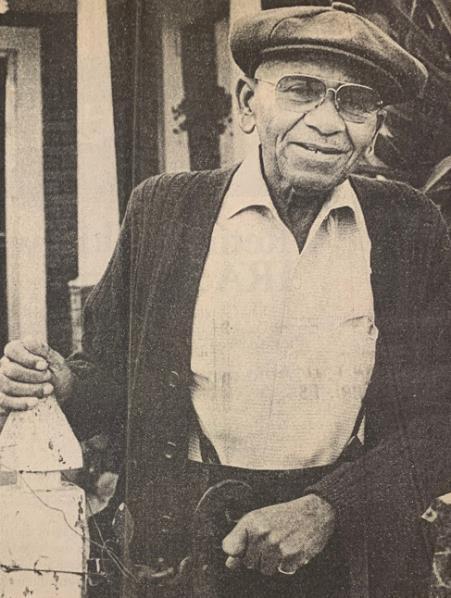
100 City of Santa Barbara, “Santa Barbara Structure Age Map,” 2020, accessed February 16, 2022, https://www.santabarbaraca.gov/services/community/historic/buildingagemap.asp. 101 “Shoeshine man not rebuffed by retirement,” Santa Barbara News-Press, 16 December 1981. 102 1947 aerial photograph, HistoricAerials.com. 103 U.S. Department of the Interior Geological Survey, Santa Barbara Quadrangle, 7.5 Minute Series (Topographic) map, 1952. 104 "SB Freeway Now Open to Drivers," Lompoc Record, 16 November 1959: 10.
African American and Black Historic Context Statement Santa Barbara, California FINAL DRAFT Historical Overview
residential area south of U.S. Highway 101/State Highway 2 (formerly Montecito Street) that had been part of the Eastside neighborhood.

Figure 23. Aerial photograph, showing blocks cleared for construction of U.S. Highway 101/State Highway 2 (1947). Source: Flight GS-EM, Frame 6-112, Harry Tubis, Inc., UCSB FrameFinder.
SANTA BARBARA’S AFRICAN AMERICAN AND BLACK COMMUNITY DURING THE MID- TO LATE 20TH CENTURY
World War II triggered a second larger wave of migrations of Black individuals to urban areas across the country. In addition to enlistment, the wartime economy produced billions of dollars in government contracts and spurred a rapid build-up of industrial and manufacturing across the country, as well as numerous job opportunities at military bases. During the 1940s, an estimated 1.5 million African American and Black men and women left the South as they sought to leave poor economic conditions, limited job opportunities, racial discrimination, and outright violence in the Jim Crow South for better employment opportunities and the hope of greater race equality in the North and Western regions of the United States. For many, the allure of steady, well-paying work at one of the military bases or associated industries attracted Black individuals to a specific locale. This second great migration resulted in the increasing
African American and Black Historic Context Statement Santa Barbara, California FINAL DRAFT Historical Overview
urbanization of the country’s Black population, as a growing number of individuals left jobs in agriculture or domestic labor for work in the cities. 105
Although Santa Barbara was not itself a major industrial or manufacturing hub, the presence of several military installments in the surrounding area and the prospect of plentiful job opportunities brought a large influx of new African American and Black men and women to Santa Barbara during World War II and in the postwar period. Oral histories and articles in the California Eagle newspaper show that many local African American and Black men from Santa Barbara also served in the military during World War II. Among the decorated veterans of the war who called Santa Barbara home were Lowell Steward, a member of the Tuskegee Airmen who flew over 143 missions during the war and received the Air Medal and a Distinguished Flying Cross, and Dr. Horace McMillan, the first Black pharmacist-mate in the Coast Guard who later became a physician and major figure in the fight for racial equality in Santa Barbara. 106 Reflecting the number of local Black veterans in Santa Barbara, a new Veteran of Foreign War (VFW) post for Black servicemen, named after white Civil War veteran Charles A. Storke, was organized by long-time resident and World War I veteran Louelen Smith Spencer, in 1941, just prior to the United States’ entry into World War II. 107 Santa Barbara also had its own interracial chapter of the United Service Organizations (U.S.O.).108

Figure 24. A mess sergeant at Santa Maria Airbase, circa 1940. Source: Black Gold Cooperative Library System.

105 “The Great Migration (1910-1970);” “The Second Great Migration,” Smithsonian American Art Museum, accessed February 17, 2022, https://americanexperience.si.edu/wp-content/uploads/2015/02/The-Second-Great-Migration.pdf. 106 John Zant, “Pilot waged war against racism,” Santa Barbara News-Press, 15 October 1995; “Recognizing Santa Barbara’s Black History,” Santa Barbara Independent, 10 February 2011; “Louelen Spencer,” February 28, 1984 obituary, locator number 20A148, available through Santa Barbara County Genealogical Society and courtesy of Gledhill Library, Santa Barbara Historical Museum. 107 “New Veterans Post in Santa Barbara,” California Eagle, 27 March 1941. 108 “Interracial Equality in U.S.O.” California Eagle, 2 December 1943.
African American and Black Historic Context Statement Santa Barbara, California FINAL DRAFT Historical Overview
Oral histories indicate that Black individuals also came to Santa Barbara during the middle of the 20th century because of educational opportunities at UC Santa Barbara, a reported demand for chauffeurs and domestic staff to support the film industry in Hollywood, or because of encouragement from family members who had already settled in the area.109 The influx of African American and Black people into Santa Barbara nearly doubled the size of the local population from around 600 in 1940 to more than 1,100 in 1950. The population continued to grow throughout the 1950s and 1960s, though at a slower pace, and may have included children as part of the postwar baby boom. 110 By 1960, the census recorded approximately 1,500 African American and Black people in the city, with 89 percent in two census tracts (Census Tract 8 and 9) generally considered the “industrial park area,” or lower Eastside.
111
Table 3: Santa Barbara’s Population Figures, 1940-1980
1940 1950 1960 1970 1980
African American and Black Residents
605 1,154 1,503 2,294 1,833 Total City Population 34,958 44,854 58,768 70,215 74,414 Percent of African American and Black Population 1.73% 2.57% 2.56% 3.27% 2.46%
Source: U.S. Census, 1940, 1950, 1960, 1970, 1980.
The demographics of Black individuals who arrived in Santa Barbara during World War II and the mid-twentieth century differed somewhat from those who settled in the city in the early 20th century. Working professionals – including doctors, social workers, and lawyers – were more common than in previous decades, particularly during the 1950s and 1960s. Examples include Dr. Horace McMillan and his wife, Jesse McMillan, who arrived in Santa Barbara in the 1950s. Dr. McMillan was one of the first Black physicians to practice medicine in Santa Barbara, while Mrs. McMillan became one of the first Black people hired to work as a social worker for Santa Barbara County.112
109 Oral history notecards, Collection of Sojourner Kincaid Rolle. 110 U.S. Bureau of the Census, "Characteristics of the Population – California." Table 32 - Age, Race, and Sex for Cities of 10,000 to 100,000: 1940 and 1930; U.S. Bureau of the Census, "General Characteristics, California," Table 34 - General Characteristics of the Population for Standard Metropolitan Areas, Urbanized Areas, and Urban Places of 10,000 or More: 1950, Census of Population: 1950, Volume II: Characteristics of the Population. Washington, D.C.: United States Government Printing Office, 1953, 5-103; U.S. Bureau of the Census, "Santa Barbara, Calif. Standard Metropolitan Statistical Area." Table P1 - General Characteristics of the Population, by Census Tract: 1960, Census of Population: 1960, Volume I: Characteristics of the Population (Washington, D.C.: United States Government Printing Office, 1963), 13. 111 Ray Loynd, “Integration Here – An Issue Coming to the Surface,” Santa Barbara Post (November 1963): 12. 112 Oral history notecards, Collection of Sojourner Kincaid Rolle; Kate Lima and Holy Snyder, “Dr. Horace James McMillan,” Santa Barbara African American Life, Culture, and Contributions, 1890-1990, Santa Barbara County Genealogical Society, accessed February 18, 2022 and July 29, 2022, https://sbgen.org/santa-barbara-african-american-life-culture-andcontributions-1890-1990/.
African American and Black Historic Context Statement Santa Barbara, California FINAL DRAFT Historical Overview
Dr. McMillan started his Family Medical Center practice in 1952 and continued until his retirement in 1988, while also founding and serving on the board of directors of the Goleta Valley Community Hospital from 1967 to 1977. 113 In 1958, he and three partners, Drs. Henry J. Hoegerman, Michael J. Lemus, and Paul Tanaka, collectively purchased the property at 101 West Arrellaga Street (1525 Chapala Street) just west of State Street and sponsored the construction of a one-story Midcentury Modern building at the site to serve as the offices for their medical practice. The integrated practice was established specifically to provide medical service to under-represented communities.114
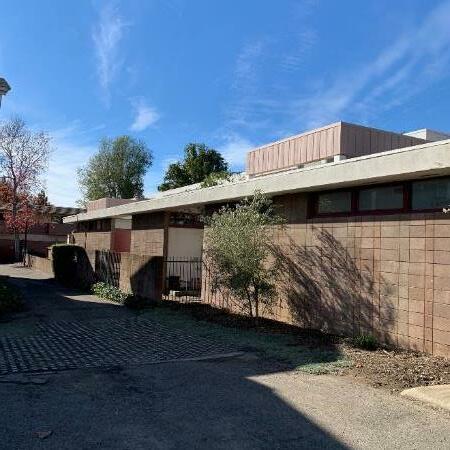
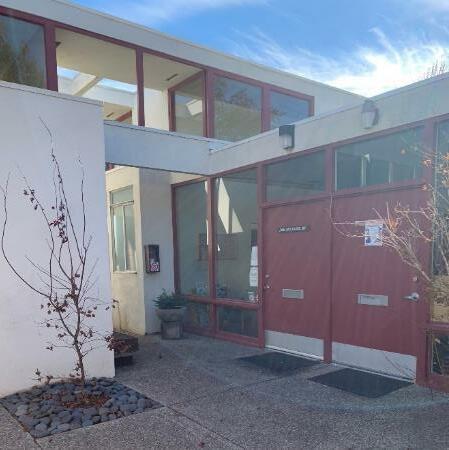
Figure 25. Dr. Horace McMillan’s Family Medical Center at 101 West Arrellaga Street completed in 1959 in the Midcentury Modern style with outdoor spaces.
Another notable professional was Anita Johnson Mackey, who arrived in Santa Barbara in 1964 and was a nationally renowned social worker who received numerous awards and distinctions for her work with the Veteran’s Administration in Santa Barbara and Los Angeles in the 1960s and 1970s.115
113 “McMillan, Horace Jim,” ca. March 6, 2001 obituary, locator number 18D-161, available through Santa Barbara County Genealogical Society and courtesy of Gledhill Library, Santa Barbara Historical Museum. 114 Original drawings and plans, 1958, City of Santa Barbara Community Development Department, Records and Archives. 115 “Anita Johnson Mackey," Santa Barbara African American Life, Culture, and Contributions, 1890-1990, Santa Barbara County Genealogical Society, accessed December 22, 2021 and July 29, 2022,https://sbgen.org/santa-barbara-africanamerican-life-culture-and-contributions-1890-1990/; Mary Every, “Anita Mackey Achives Goals, Inspires Others,” Santa Barbara News-Press, January 17, 1989.
African American and Black Historic Context Statement Santa Barbara, California FINAL DRAFT Historical Overview
Also arriving later in the 1960s was William (Bill) Downey, who started his journalism career in Santa Barbara through a three-part series on “A Negro Looks at Santa Barbara,” from September 20 to 22, 1967. Published in the Santa Barbara News-Press, the newspaper then hired Downey as its first African American reporter.116

Mackey, Dr. McMillan, and Mrs. McMillan joined Dr. Frances Ford, the podiatrist who started practicing in Santa Barbara in the 1920s, as some of the African American and Black professionals who practiced in Santa Barbara. These new arrivals contributed to the cultural, political, social, and spiritual development and enrichment of the African American and Black community and expanded on the accomplishments of the previous generation.
Figure 26. Bill Downey conducting an interview for his three-part series in the Santa Barbara News-Press. Source: “A Negro Looks at Santa Barbara: ’I Want to Feel Like I Can Go Anywhere Like Anybody Else,’” Santa Barbara News-Press, 20 September 1967, Black History File, Gledhill Library.

New Black churches were founded during the postwar period. King David Simms and his wife Beatrice arrived in Santa Barbara from Texas in 1944 and founded the Lewis Chapel Christian Methodist Episcopal (CME) Church shortly afterward, along with Simms’ brother Bodie. Members of the church initially met in the couple’s house at 221 Santa Barbara Street in the Lower State Street neighborhood and at other churches and houses in the community until 1957, when a dedicated building for the church opened at 202 East Gutierrez Street.
117
116 “Guide to the William Downey Papers,” UC Santa Barbara Library, Special Research Collections, California Ethnic & Multicultural Archives, African American Collection, accessed June 15, 2022, https://www.library.ucsb.edu/specialcollections/cema/downey. 117 Mary Jacob, "Lewis Chapel Christian Methodist Episcopal Church," Santa Barbara African American Life, Culture, and Contributions, 1890-1990, Santa Barbara County Genealogical Society, accessed December 22, 2021 and July 29, 2022,https://sbgen.org/churches-african-american-exhibit/ ; “Beatrice Simms,” January 11, 1974 obituary, locator number 20190, and “Bodie Simms,” May 31, 1984 obituary, locator number 20A-154, available through Santa Barbara County Genealogical Society and courtesy of Gledhill Library, Santa Barbara Historical Museum.
African American and Black Historic Context Statement Santa Barbara, California FINAL DRAFT Historical Overview

Figure 27. The Lewis Chapel CME church at 202 E. Gutierrez Street. Figure 28. Beatrice (Raines) and King David Simms. Source: Santa Barbara County Genealogical Society, courtesy of Wanda Lynn Thomas.

To support the Eastside community, Dr. McMillan and others in 1964 started the idea of a center to provide basic emergency services, counseling, youth programs, cultural enrichment, meeting space, and other services for the surrounding community. Though local activism, the City in 1972 secured federal funding to construct Eastside Neighborhood Facilities Center (now known as the Franklin Neighborhood Center) that opened at 1136 East Montecito Street in 1974. 118 Bill Simms, son of Bodie Simms, was actively involved through his role as the City’s Human Relations Director.119
The assassination of Dr. Martin Luther King Jr. in 1968 precipitated the establishment of another important community asset. Motivated by his death, donors across the city raised $35,000 to open a new wing of the Eastside Library, dedicated to Dr. King. The MLK meeting room and patio opened in 1973 and became one of the most utilized public spaces by the city’s Black residents.120 With the Eastside Library constructed adjacent to the Eastside Neighborhood
118 City of Santa Barbara Resolution No. 7594, “A Resolution of the Council of the City of Santa Barbara Authorizing the City Administrator to File an Application for Federal Assistance with the Department of Housing and Urban Development, Neighborhood Facilities Grant Program for the Construction of an Eastside Neighborhood Facilities Center,” August 29, 1972. Santa Barbara City Clerk. 119 “William ‘Bill’ Simms,” Santa Barbara African American Life, Culture, and Contributions, 1890-1990, Santa Barbara County Genealogical Society, accessed December 22, 2021 and July 29, 2022, https://sbgen.org/santa-barbara-african-american-lifeculture-and-contributions-1890-1990/. Additional information about the roles of Dr. McMillan and Mr. Simms was provided through personal communication with Sojourner Kincaid Rolle. 120 Personal communication between Sojourner Kincaid Rolle and Healing Justice.
African American and Black Historic Context Statement Santa Barbara, California FINAL DRAFT Historical Overview
Facilities Center and near Franklin Elementary School, the grouping became known as the Franklin Complex.121
The Fight for Civil Rights Despite projecting to the world the reputation that Santa Barbara was a peaceful, welcoming community, African American and Black residents in the city continued to face intractable racial discrimination in all areas of their daily lives that continuously limited the community’s progress. As was the situation throughout the United States in the postwar years, de facto (in fact, even if not lawfully recognized) and de jure (by law) segregation continued to restrict opportunities for housing, employment, education, and equal access to services for African American and Black citizens.
Matching the efforts of the Civil Rights movement growing across the country in the 1950s and 1960s, Santa Barbara’s African American and Black community mobilized to expose these inequalities, challenge accepted norms, and fight for equal rights and opportunities through protests, lawsuits, and other actions. A reinvigorated chapter of the National Association for the Advancement of Colored People (NAACP) aided the community’s efforts. In 1951, the legal redress committee of the local NAACP chapter, headed by Bert Blackman, led an investigation into discrimination in Santa Barbara’s education system after five Black girls at Santa Barbara High School informed the local chapter of being segregated from white students in class. 122 The investigation supported the girls’ claims and revealed that Black and minority students had been deliberately segregated and received more demerits than white students. No Black teachers were employed in the city’s schools, and some teachers were reported as using derogatory words and expressions toward students. The NAACP chapter approached local school authorities and asked them to consider several ideas, including intensive training for teachers on discriminatory treatment of minority students, planning an annual Negro History Week celebration, and hiring Black teachers. In October 1951, the local school board agreed to hire a Black teacher by the following semester.
121 Personal communication with Sojourner Kincaid Rolle. 122 Art Dulgoff, “School Bias Erupts in Santa Barbara,” California Eagle, 18 October 1951; Art Dlugoff, “School Bias Again Riles Santa Barbara,” California Eagle, 25 October 1951.
African American and Black Historic Context Statement Santa Barbara, California FINAL DRAFT Historical Overview
Toward the end of the decade, the local NAACP chapter turned its attention to housing discrimination. The organization’s Housing Committee, led by Dr. McMillan, sponsored a 1957 survey of local real estate agents that exposed the widespread extent of housing discrimination, as well as a 1958 city-wide survey to determine the number of sub-standard dwellings in the city and the severity of housing needs among Black residents.123 In the 1960s, Figure 29. Dr. Horace McMillan. Source: UC Santa Barbara Black attorney Cornel Young led legal Library, Special Collections, CEMA. challenges on behalf of the NAACP, which allowed Black individuals to move into previously restricted business and residential areas in Montecito and Hope Ranch for the first time.124 The NAACP also tackled discriminatory hiring practices. In 1963, the organization conducted a survey of more than 200 Black families to identify their current employment status and skills.125 In 1967, they investigated the hiring practices of local defense contract suppliers, who were suspected of refusing to hire Black workers. Similarly, the organization exposed discrimination at the local banks after a young Black woman, who had been encouraged to apply for a job opening over the phone, was told upon arriving at the bank to submit an application that they were not hiring. The NAACP’s efforts resulted in three Black individuals being hired at local branches of the Bank of America within two days.126 Among the three was Willie Rowan, who continued the fight for racial justice and later became president of the local NAACP chapter.127 In spite of these efforts, along with federal actions such as the 1964 Civil Rights Act, 1965 Voting Rights Act, and 1968 Fair Housing Act, discrimination persisted in the late 1960s and 1970s. In the 1960s, the Santa Barbara News-Press published a series of articles that exposed continuing housing and job crises among the African American and Black community and a growing sense
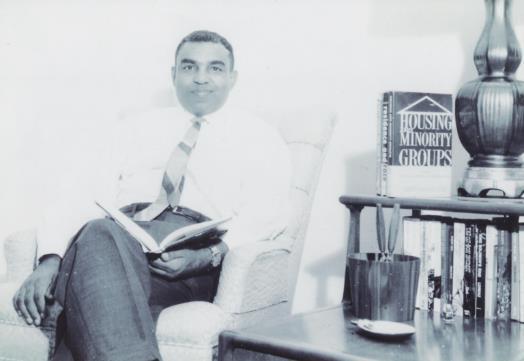
123 “Plans for Negro Housing Study Told at Social Work Meeting,” Santa Barbara News-Press, October 25, 1957, Black History File, Gledhill Library, Santa Barbara Historical Museum; Miller, “The History of Santa Barbara’s National Association for the Advancement of Colored People (NAACP),” 63-64. 124 Black history calendar, Collection of Sojourner Kincaid Rolle. 125 “Negro Jobs Survey Conducted,” Santa Barbara News-Press, 18 November 1963. 126 Miller, 65; Loynd, “Integration Here,” 12 127 “Willie M. Rowan,” Black history calendar, Collection of Sojourner Kincaid Rolle.
African American and Black Historic Context Statement Santa Barbara, California FINAL DRAFT Historical Overview
of hopelessness among Black youth about their job prospects. Although employers did not have official policies against hiring people of color, the reporting showed that they often refused to hire Black individuals, particularly for positions that were public facing, even when jobs were available, because they felt their customers would object. Instead, Black individuals, regardless of their experience and educational background, continued to find that the majority of jobs offered to them were low-paying, service positions working as maids, butlers, housekeepers, chauffeurs, seamstresses, gardeners, janitors, dishwashers, or day laborers.128
Facing a seemingly unchanging situation, some local Black groups and individuals began to look for solutions outside of traditional, conciliatory social-political systems and processes and take direct action against racial inequality. In 1964, the Black Muslims, led by Bobby XX, opened a local headquarters at 416 East Haley Street.129 Many of the Black Muslims’ recruits reportedly consisted of young Black men and teenagers who were discouraged by the treatment and lack of opportunities they experienced in Santa Barbara.130

Figure 30. Two UCSB students conducting an interview with a Black woman as part of the 1963 NAACP jobs survey. Source: “Negro Jobs Survey Conducted,” Santa Barbara News-Press, 18 November 1963, Black History File, Gledhill Library.
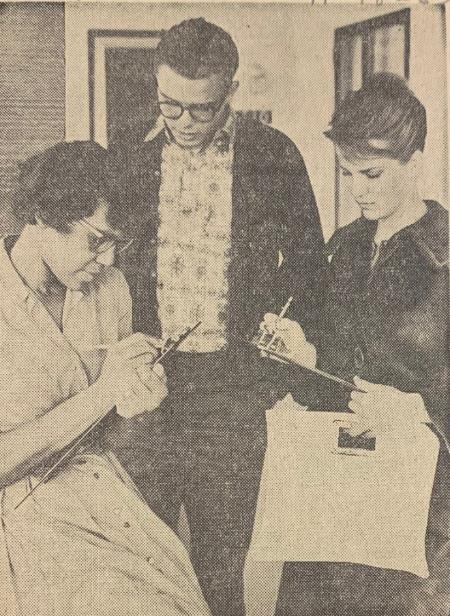
Believing that racial integration was “an impossible task,” the group advocated for creating a separate Black society and announced that it planned to build its own apartment buildings and stores in the Eastside neighborhood, though it is unclear if any of these buildings were constructed.131 After their landlord “requested” that the group vacate their initial headquarters,
128 Barney Brantingham, "Job Training Projects Help, But No Real Breakthrough," Santa Barbara News-Press, 15 December 1967. 129 "Black Muslim Unit to Vacate Offices," 21 March 1964, 129 “Injunction Bans Muslim Paper Sales,” 7 February 1966; “Black Muslim Ban Sought by Shopping Unit,” 4 January 1967, newspaper clippings, collection of Sojourner Kincaid Rolle. 130 Barney Brantingham, "Black Muslims Are Blamed for Tension Among Negroes," Santa Barbara News-Press, 21 June 1964. 131 Barney Brantingham, "Black Muslims Planning Apartments, Stores Here," Santa Barbara News-Press, 13 February 1965.
African American and Black Historic Context Statement Santa Barbara, California FINAL DRAFT Historical Overview
they relocated to 806 East Haley Street.132 By 1968, city directories indicate that the group had a meeting hall, mosque, and bakery across the street from each other at 301 and 302 East Haley Street.133
Newspapers state that Black ministers spoke out against the Black Muslims and that local African American and Black community members, including community leader Dr. McMillan, disagreed with the group’s more extreme philosophies, preferring the racial integration and civil rights movement approach espoused by Dr. Martin Luther King, Jr.134 However, interviews with local Black individuals shows that the African American and Black community members generally accepted and understood the perspective of the Black Muslims.
135
Resistance to persistent discrimination also galvanized young people. Members of Black student groups, including the Black Action Group at Santa Barbara City College and Harambee at UC Santa Barbara, described the growing impatience among local Black youth and the possibility of riots breaking out in Santa Barbara, as alternative, peaceful methods repeatedly failed to enact meaningful, long-lasting change.136 In 1968, 12 Black students barricaded
Figure 31. Second Black Muslim headquarters at 806 East Haley Street in 1964. Source: “Tension Blamed on Black Muslims,” Santa Barbara News-Press, 21 June 1964, Black History File, Gledhill Library.
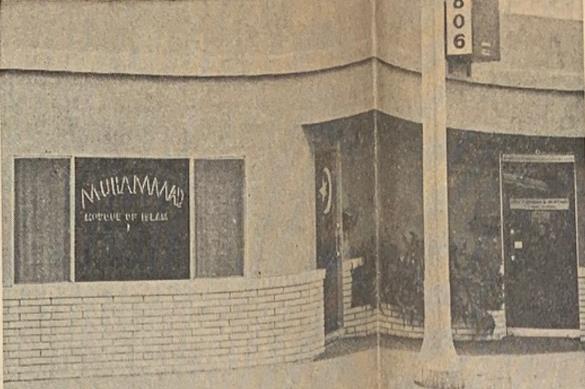

132 "Muslims Finding Local Soil Barren," 19 August 1964.
132 “Injunction Bans Muslim Paper Sales,” 7 February 1966; “Black Muslim Ban Sought by Shopping Unit,” 4 January 1967, newspaper clippings, collection of Sojourner Kincaid Rolle. 133 1968 Santa Barbara City Directory. The city’s survey file for 301 East Haley Street noted that Mr. Joseph Stephens (also known as Yusuf Bey) used the building as an assembly space and school for African American Muslims. He was also known for starting a bakery in Santa Barbara called Your Black Muslim Bakery, which catered to strict Muslim dietary restrictions. Additional research in city directories did not find a listing for a bakery at 301 or 302 East Haley Streets from 1968 to 1970, though the Muhammad Meeting Hall and Muhammad’s Mosque of Islam are listed at those addresses, respectively. 134 "Muslims Finding Local Soil Barren, 19 August 1964, “Injunction Bans Muslim Paper Sales,” 7 February 1966; “Black Muslim Ban Sought by Shopping Unit,” 4 January 1967, newspaper clippings, collection of Sojourner Kincaid Rolle. 135 Bill Downey, “Teachings of Black Muslims Draw Nonmember Reaction,” 22 September 1967, “Injunction Bans Muslim Paper Sales,” 7 February 1966; “Black Muslim Ban Sought by Shopping Unit,” 4 January 1967, newspaper clippings, collection of Sojourner Kincaid Rolle. 136 Barney Brantingham, "Impatient Young Negroes Call For Change in Job Chances," Santa Barbara News-Press, 12 December 1967.
African American and Black Historic Context Statement Santa Barbara, California FINAL DRAFT Historical Overview
themselves inside North Hall at UC Santa Barbara and temporarily renamed it “Malcolm X Hall” in order to demand culturally relevant curriculum and a more inclusive and safe campus environment for Black students and other students of color. Their actions led to the establishment of the Department of Black Studies and the Center for Black Studies at UC Santa Barbara and paved the way for the establishment of the university’s Chicano and Chicana Studies Department, Asian American Studies Department, Department of Feminist Studies, and other multicultural research.
137
2,500
2,000
1,500
1,000 City of Santa Barbara African American and Black Population, 1860-1980
2,294
1,503
1,154 1,833
500
0 0 38 63 22 19 77 186 525 605
1860 1870 1880 1890 1900 1910 1920 1930 1940 1950 1960 1970 1980
Source: U.S. Census, 1860-1980.
In spite of these efforts, the slow progress toward greater racial equality and continuing lack of job and housing opportunities, led many young Black people to leave Santa Barbara in the late 1960s and 1970s. Federal census records reflect the exodus of Black people from the city during this period. While Santa Barbara’s overall population increased in the 1970s, the city’s African American and Black population decreased by 20% from 2,294 in 1970 to 1,833 in 1980, the first time the community’s numbers had dropped since the 1890s.138
137 Jeffrey C. Stewart, “North Hall Takeover 50 Years Later,” The Current, UC Santa Barbara, 9 October 2018, accessed 2 March 2022, https://www.news.ucsb.edu/2018/019214/north-hall-takeover-50-years-later. 138 U.S. Bureau of the Census, "Census Tracts, Santa Barbara, Calif. Standard Metropolitan Statistical Area," Table P-1. General Characteristics of the Population: 1970, Census of Population and Housing: 1970. (Washington, D.C.: United States Government Printing Office, 1972), P-1; U.S. Bureau of the Census, “General Social and Economic Characteristics, California,” Table 58. Race by Sex: 1980, 1980 Census of Population, Volume 1 (Washington, D.C.: U.S. Government Printing Office, July 1983), 6-50.






